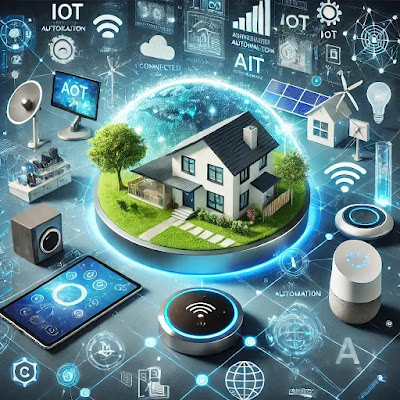Smart home technology is transforming the way we interact with our living spaces. With the integration of IoT (Internet of Things), homes are becoming more efficient, secure, and convenient than ever before.
Why Smart Home Technology is Important?
- Convenience: Automates daily tasks like lighting, temperature control, and security.
- Energy Efficiency: Reduces electricity consumption with smart appliances.
- Security Enhancement: Provides real-time surveillance and remote monitoring.
- Voice Control & AI Assistance: Integration with Alexa, Google Assistant, and Siri.
- Remote Access: Control home devices from anywhere using a smartphone.
Best Smart Home Devices
1. Smart Speakers & Voice Assistants
- Amazon Echo (Alexa): Controls home automation and answers queries.
- Google Nest Hub: Integrates with Google Assistant for smart home control.
- Apple HomePod: Works seamlessly with Siri and HomeKit.
2. Smart Lighting
- Philips Hue: Customizable lighting with color-changing options.
- LIFX Smart Bulbs: Wi-Fi-enabled bulbs for automation.
- TP-Link Kasa: Affordable smart lighting solutions.
3. Smart Thermostats
- Nest Thermostat: Auto-adjusts temperature based on habits.
- Ecobee SmartThermostat: Includes remote room sensors.
- Honeywell T9: Wi-Fi-enabled climate control system.
4. Smart Security Systems
- Ring Video Doorbell: Monitors entry points with HD video.
- Arlo Pro Cameras: Wireless surveillance cameras with night vision.
- August Smart Locks: Keyless entry and remote access.
5. Smart Appliances
- Samsung Smart Refrigerator: Touchscreen-enabled fridge with inventory tracking.
- Roomba Robot Vacuum: AI-powered cleaning automation.
- LG Smart Washer/Dryer: Wi-Fi control for laundry management.
How to Set Up a Smart Home
1. Choose a Smart Home Ecosystem
- Amazon Alexa: Compatible with a wide range of devices.
- Google Assistant: Works best with Google services.
- Apple HomeKit: Ideal for Apple users.
2. Install a Smart Hub
- Acts as a control center for multiple devices.
- Examples: Samsung SmartThings, Hubitat Elevation.
3. Connect Smart Devices
- Pair devices with your ecosystem via Wi-Fi or Bluetooth.
- Ensure all devices are compatible with your home network.
4. Automate Tasks & Routines
- Set schedules for lights, thermostats, and security cameras.
- Use voice commands to control multiple devices at once.
5. Enhance Security & Privacy
- Change default passwords on all smart devices.
- Use encrypted networks and two-factor authentication.
Challenges of Smart Home Technology
- Cybersecurity Risks: IoT devices are vulnerable to hacking.
- Compatibility Issues: Some devices may not work across different ecosystems.
- High Initial Costs: Smart home upgrades can be expensive.
- Privacy Concerns: Voice assistants collect user data.
Future Trends in Smart Home Technology
- AI-Driven Automation: AI will predict user behavior for smarter home control.
- 5G-Powered Smart Homes: Faster and more reliable connections for IoT.
- Energy-Efficient Smart Homes: Enhanced automation to reduce electricity costs.
- Smart Cities Integration: Smart homes connecting to larger city infrastructure.
- Voice Recognition Improvements: More personalized and accurate responses.
Conclusion
Smart home technology is making daily life more efficient, secure, and comfortable. By investing in smart devices and automation, homeowners can enjoy a seamless and futuristic living experience.
Want to upgrade your home? Start with smart speakers, lighting, and security systems today!
